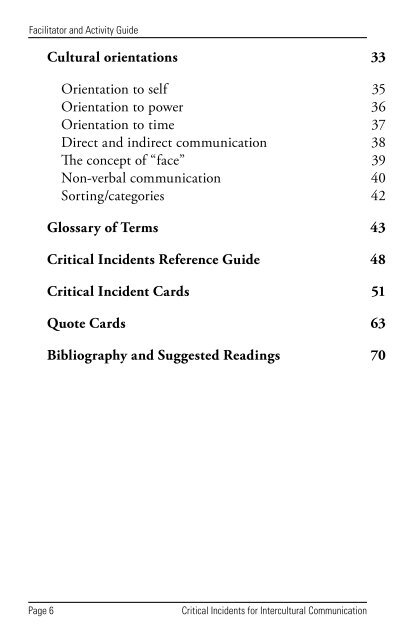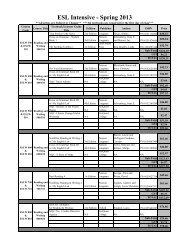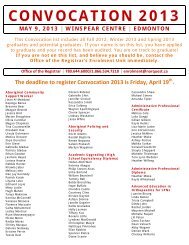Critical Incidents for Intercultural Communication - NorQuest College
Critical Incidents for Intercultural Communication - NorQuest College
Critical Incidents for Intercultural Communication - NorQuest College
- No tags were found...
You also want an ePaper? Increase the reach of your titles
YUMPU automatically turns print PDFs into web optimized ePapers that Google loves.
Facilitator and Activity GuideCultural orientations 33Orientation to self 35Orientation to power 36Orientation to time 37Direct and indirect communication 38The concept of “face” 39Non-verbal communication 40Sorting/categories 42Glossary of Terms 43<strong>Critical</strong> <strong>Incidents</strong> Reference Guide 48<strong>Critical</strong> Incident Cards 51Quote Cards 63Bibliography and Suggested Readings 70Introduction - What Are <strong>Critical</strong><strong>Incidents</strong>?Facilitator and Activity Guide<strong>Critical</strong> incidents are tools <strong>for</strong> increasing our awareness andunderstanding of human attitudes, expectations, behaviours,and interactions. They are intended to engage participantsat a meaningful, personal level as they examineattitudes and behaviours that might be critical to theireffectiveness in the roles they are already per<strong>for</strong>ming or preparing<strong>for</strong> (in the workplace, in educational settings, andin society at large). Triandis first used critical incidents todevelop cross-cultural competence in the 1960s in his workwith cultural assimilators (see also Triandis, 1994). 1<strong>Critical</strong> incidents in intercultural communication trainingare brief descriptions of situations in which a misunderstanding,problem, or conflict arises as a result of the culturaldifferences of the interacting parties, or a problem ofcross-cultural adaptation and communication. Each incidentgives only enough in<strong>for</strong>mation to set the stage andthen describes what happened and possibly manifests thefeelings and reactions of the people involved. It does notexplain the cultural differences that people bring to the situation;these are meant to be discovered or revealed as partof the different activities outlined in this guide.The critical incidents in this collection were gathered fromopen-ended interviews with students and instructors from1 You will find all the references cited in the bibliography section, where we have alsoprovided you with a list of suggested readings.Page 6<strong>Critical</strong> <strong>Incidents</strong> <strong>for</strong> <strong>Intercultural</strong> <strong>Communication</strong><strong>Critical</strong> <strong>Incidents</strong> <strong>for</strong> <strong>Intercultural</strong> <strong>Communication</strong> Page 7
















